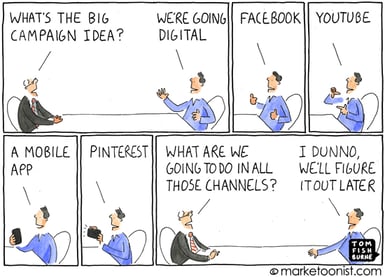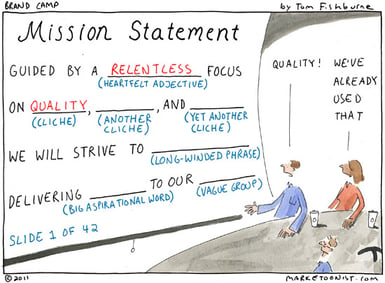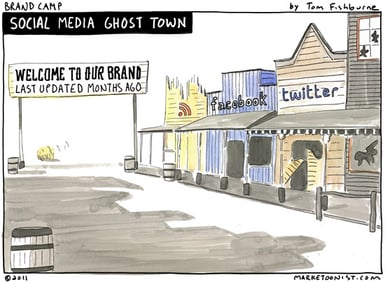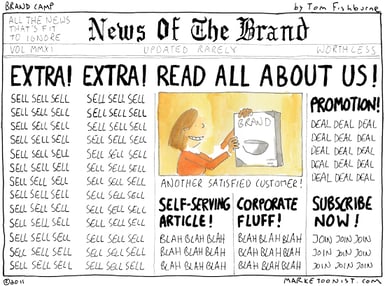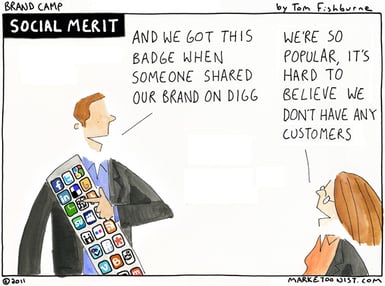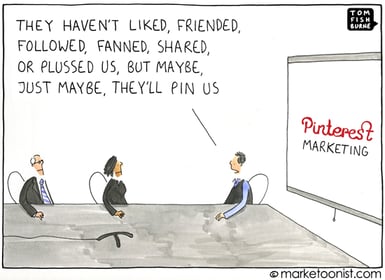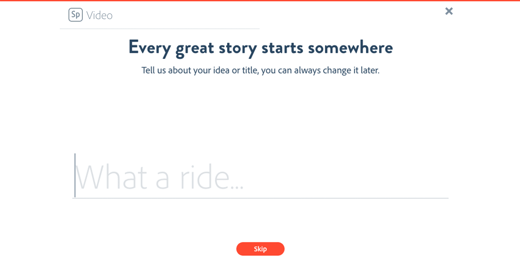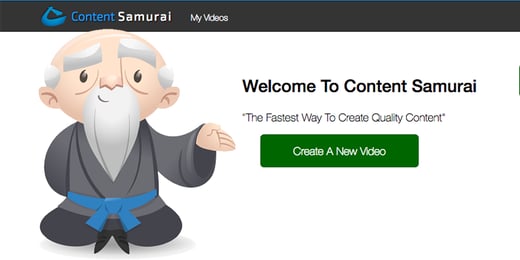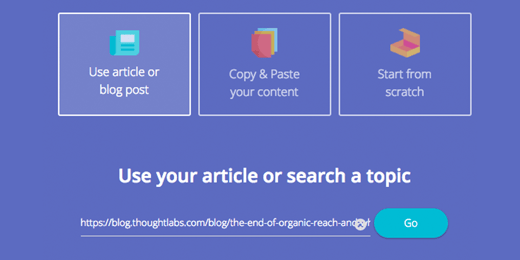In the past I have done analysis and recommendations/lessons from multiple brand's Facebook Pages as part of my Brand Focus series. I'm now adding a second type of analysis to my brand focus series. Instead of focusing on a particular page, I will instead focus on a Facebook campaign that a brand is executing in order to understand what their goals seem to be, how their campaign has performed, and how it could have been improved to reach its full potential. Using the inferred goals, the target for the campaign, and the in-depth analysis of the campaign content's performance and how it stacks up against the brand's usual content, I'll also examine whether or not a campaign provides a return on investment for the brand!
The first Campaign Focus in my Brand Focus series is the McAfee "Most Dangerous Celebrities of 2012" campaign from September.
Image Credit: Tom Fishburne
Campaign Background and Focus:
The "Most Dangerous Celebrities of 2012" campaign was an educational awareness campaign that ran on McAfee's Facebook page for the duration of September of 2012. The campaign seeks to educate their fans about the dangers of searching for popular trending topics, such as certain celebrities, which could return malicious results online. Throughout the campaign tactics such as trivia questions, simple infographics, a cover photo featuring Emma Watson as 2012's Most Dangerous Celebrity, and that's pretty much it. The campaign follows a pattern of infographic, triva question, infographic, trivia question, with almost no variation throughout the month. Rinse and repeat.
Image Credit: Tom Fishburne
Are Best Practices Used When Posting?
Though early on we have some of the best posts in the campaign where best practices are observed and McAfee is very active in the discussions, these are few and far between after the first week of the campaign. More often than not, best practices aren't observed, like a post which features only text, no link, picture, or video. Posts like this one are ranked lowest by Facebook's EdgeRank, which decides how often posts appear in fan's newsfeeds. Also, that post was supposed to be a trivia post, but they never bothered to reveal the answer to their question.
Image Credit: Tom Fishburne
Is the Messaging Clear/Consistent?
The campaign messaging varies and isn't always clear. What is clear is that some fans don't understand what McAfee means by "Most Dangerous Celebrity." Though McAfee does occasionally refer to them as "the most dangerous to search for" these celebrities are most often referred to simply as the "most dangerous." This leads to One fan assuming McAfee means Emma Watson is an online criminal, and when this fan asked what they meant, no one ever answered his question. Considering that the goal of this campaign should be to educate, why did no one actively respond to questions like this one?
Image Credit: Tom Fishburne
Does the Brand Actively Participate?
This leads to the next issue. Considering that even what would be "good" engagement for them is much less than the leading competitors address on Facebook in a day, and certainly when compared against those same competitor's most successful campaigns, it's very surprising that no one took the time to answer questions about this campaign or engage with fans more actively on posts.There are multiple examples where content was posted and on the posts where they did use best practices they didn't bother to respond to any type of comments or questions:
- http://www.facebook.com/photo.
php?fbid=10151203924130250& set=a.447297105249.238923. 220342685249&type=1 - http://www.facebook.com/photo.
php?fbid=10151207401855250& set=a.447297105249.238923. 220342685249&type=1
Or only respond to support issues and ignore feedback and questions regarding the campaign.
Image Credit: Tom Fishburne
Does the Campaign Offer Quality Content and Strong Conversations?
Just like long wars are bad for morale, long campaigns are bad at keeping the attention of a community, unless it's something very fun and creative like Oreo's 100 day campaign. McAfee did space out the posts, so fans didn't get pounded with campaign content all day every day for the entire month (so +1 there), but there were still a lot of campaign posts over a very long period. The campaign was a very simple and informative concept, to explain which celebrities are most dangerous to search for and highlight a common tactic of online criminals - manipulating the results of popular searches to serve malware rather than relevant information. There was a lot of room to expand on this simple topic, such as talking more about the tactics used, discussing high profile attacks in the past, and of course tips for how to avoid the malicious sites, but there was very little of this, for the most part the campaign held on to a very narrow focus, providing no new value for those who were already following the campaign. With a broader focus, it would be a strong campaign to run for a week or two, but with a narrow focus and a lots of space to fill over the course of a month, each new trivia question and infographic in this campaign felt like more of the same.
Most perplexing of all is that at the start of the campaign, McAfee demonstrates effective use of best practices in the campaign's posts, and they actively responded to comments (even though there are more comments on those first posts because the use of best practices allowed them to reach more of their fans in the newsfeed). Yet, within 4 days, best practices are tossed out, and rarely appear in posts, and responses to comments are non-existent. When McAfee does respond, there's no pattern. In one post already linked above, they respond to only a support issue and ignore multiple comments about the campaign content, then on another, they ignore a support issue altogether. If there's no pattern to who gets responded to and in what priority, then there probably is no plan, no priority. If McAfee had started out weak, recognized their mistakes and learned from them, improving their performance week over week, that would be one thing, but they actually seem to just stop caring about a month long campaign 4 days in.
Image Credit: Tom Fishburne
Does the Campaign Fulfill a Business Need?
Some campaigns are meant to raise brand awareness. Some are meant to educate. A campaign can have any goal that you can measure an ROI against so long as the campaign's goal serves a business need. Awareness can be valuable because it can increase reach, helping you reach more potential customers. Education can be valuable as well, and it may be easier to measure directly in terms of value. If you educate customers on a risk that your product or service can help mitigate, that can help drive new sales and repeat business. It's not all that difficult to accurately measure the ROI of a campaign, even if you're not involved with it. You may not know what the overall goals of the campaign were, but you can see the target (how long the campaign lasts), and the tactics (the methods used to reach the proposed goals within the timeframe described as the target). We can infer that the goals of this campaign are to educate consumers on the risks of manipulation of popular search results (a benefit of this could be helping more of McAfee's customers avoid dangerous websites, which leads to fewer infections, less support requests to remove infections, and a better experience for customers), and to raise awareness of McAfee's products using a hot topic (popular celebrities), much in the same way that the attacks the campaign focuses on hope to use celebrities to reach more victims, McAfee hoped to use these celebrities to create viral content that would be shared, netting them better reach than their usual non-campaign content.
So, with what data we do have available, lets see if we can determine how well they met that goal.
For the month of September, McAfee had 50 posts. Of those 50 posts, 16 were a part of their campaign. This leaves 34 posts that are not dedicated to this campaign, which is roughly double the number of campaign posts.
For a benchmark, here are the average number of interactions for September on:
- Campaign Content - 92
- Non-Campaign Content - 157
- All Content- 136
That doesn't look very good so far, but there are almost double the number of non-campaign posts, and just a few outliers in the non-campaign content could skew the averages in favor of non-campaign content, even if it didn't perform as well consistently across multiple posts. So, next we should look at the campaign and non-campaign post with the best and worst engagement. To get an idea of where we stand, we'll compare how many posts from each category reached the following numbers of interactions:
- 100 (or less)
- Campaign - 11
- Non-Campaign - 12
- 101 - 200
- Campaign - 4
- Non-Campaign - 15
- 201 - 300
- Campaign - 0
- Non-Campaign - 4
- 301-400
-
- Campaign - 0
- Non-Campaign - 3
- 400+
- Campaign- 1 (This was one of those few great posts I mentioned at the beginning of the campaign)
- Non-Campaign - 1
From those numbers we can see that 11 of the campaign's posts have 100 or fewer interactions. Almost 70% of the campaign's posts received less than the average number of interactions on all content posted for the month of September. 94% of the campaign's posts received 200 or fewer interactions, and only 6% (one post) of the campaign content reached more than 400 interactions. Compare this with only 80% of the non-campaign content for the month receiving 200 or fewer interactions, and 21% of non-campaign content reaching more than 201 interactions, compared to 6% of campaign content. It is quite clear that the campaign under performed compared to McAfee's regularly scheduled programming.
Here we can consider the opportunity cost. A campaign has an opportunity cost because you could be posting something each day during that campaign that has nothing to do with that campaign. Ideally, what you're posting during the campaign should perform better than this typical daily content if the goal is to create awareness. When you consider the opportunity cost of posting "Most Dangerous Celebrities" content, this campaign doesn't deliver much in the way of ROI because the regular, cheaper to produce content McAfee would have shared instead could have reached more eyes. I'm unsure of what the monetary cost of the campaign were, but I do know that you cannot use a celebrity in your marketing without their permission, and that permission will come with a price tag. Of course you could try to see if you get could get by with it, but when you're going to plaster her face on top of your Facebook page with "2012's Most Dangerous Celebrity" that's probably not a risk the legal department is willing to take. If an agency creates infographics for your campaign, that costs money. If it's made internally, that person could be creating content that would resonate better with your community, giving you a better ROI on the time spent producing that content. I'm sure there was some decent capital invested in this campaign, and in my opinion, they didn't get any return on it.
The second inferred goal is education. There are some educational posts that share tips or interesting statistics, but they're overshadowed by repetitive infographics that track the lives of celebrities and conversational trivia questions that focus on celebrities rather than security. When you further consider many of the questions raised by the campaign from McAfee's fans went unanswered, and that the campaign content performed so poorly, it doesn't feel like very many people were informed on how to avoid this threat by the campaign and it's content. Most of the content feels more like link bait than educational or valuable.
So, I have to say no, this campaign did not provide a return on investment for McAfee, even if the only investments were their social team's time (though it likely goes beyond that).
Image Credit: Tom Fishburne
So, the lessons for you to apply to your brand from these mistakes are:
- Use best practices when posting. Nothing should ever go out as just a plain text post, no one will ever see it in the newsfeed. Which means no one will ever see it, period.
- Always be active, and be doubly active during campaigns. No one wants to talk to a brick wall. Responses from the brand help drive the conversation. The comment "Who cares?" appeared in the comments of a post near the end of the campaign, and rightfully so. If McAfee won't explain what the messaging means to someone who is confused, and isn't interesting in having actual conversations about their content, just pushing out meaningless trivia and infographics, then why would anyone else care any more about their content it than McAfee does?
- Have clear messaging. "Emma Watson is 2012's Most Dangerous Celebrity" could mean a lot of things. For all I know she going around busting kneecaps, it's not always clear what they mean by that. Even worse, they don't make an effort to explain it to those who are confused. Also, they vary between saying "Most Dangerous to search for" and simply "Most Dangerous." So the messaging isn't consistent either. Once it was obvious fans were confused, they should have stuck with the clearer messaging, rather than flip flopping back and forth.
- Create value and stay focused. No one will care about your content if it isn't valuable. Don't pose a problem that affects your customers, and then not offer them the solution. Don't overshadow that focus of "here's the problem, here's how to fix it" with useless information.
- Long campaigns suck. If it's something fun that may not be necessarily true, but Oreo's campaign was supported by 4 agencies working together very closely. It was very expensive, and didn't focus on products, education, or anything of that sort. It was pure awareness, fun content people would want to share because it made them feel good or it made them laugh. This wasn't fun, it was informative, and pretty basic. There were only so many times you could post about it before it feels like you're telling the same story over again in a slightly different way. No one wants to read the same story over again each day with slight variations for a solid month.
- Don't let up, and don't back track. I can't begin to understand why McAfee started out so strong, then stopped responding when they could have answered the comments on the new posts in half the time they did their first posts. Or why they decided it would be a good idea to post text only posts, or abandon best practices in the middle of a campaign. There's no good reason to start out strong and then perform progressively worse. Instead, you should be learning from your current efforts so you can do an even better job the next day!
- You don't want to run a bad campaign, because you never know who may be watching. :)
Oct 22, 2012
